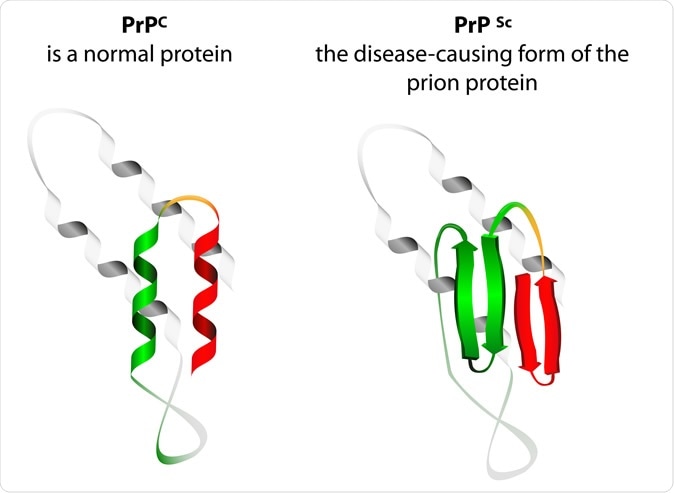Prion proteins are known to cause scrapie – a neurodegenerative condition. It is capable of debilitating damage to the nervous system. Researchers have successfully devised a treatment for this condition which prolonged the lives of the lab mice infected with the prions. For their approach the researchers used antisense oligonucleotides (ASOs). These antisense oligonucleotides are synthetic compounds that have been made to inhibit the formation of the rogue proteins. The study was titled, “Antisense oligonucleotides extend survival of prion-infected mice” and was published in the latest issue of the journal JCI Insight.
The researchers explained that when a harmless prion protein molecule becomes abnormal, it tends to gather in clusters and forms filaments within the body including the brain. These prions then go on to affect the central nervous system of the animal they infect and cause almost always fatal condition called scrapie. Scrapie has been seen to affect domestic animals such as sheeps, goats, cows etc. this form of prion disease can also be transmitted to rodents – mice and rats. The prion disease studied here is similar also with the human prion disease or Creutzfeldt-Jakob disease. Creutzfeldt-Jakob disease also known as the mad-cow disease is presently almost always fatal and has no known cure. The researchers on this study explain that their experimental model in the lab mice with scrapie is thus an important tool to study human prion disease and possibly develop a valuable treatment modality for the condition.

Prion an composed of protein in a misfolded form. Prions are responsible for the transmissible mad cow disease. Image Credit: Designua / Shutterstock
The antisense oligonucleotides ASO1 and ASO2 were specially designed by the Ionis Pharmaceuticals. The research was conducted by scientists at the National Institutes of Health. They developed the antisense oligonucleotides andinjected these into the spinal fluid of the mice. These mice had already been infected with scrapie prior to the experiment. Some of the mice were exposed to the scrapie proteins within a few weeks after they were administered the antisense oligonucleotides. The study was conducted at the Rocky Mountain Laboratories (RML) in Hamilton, Montana, (part of the NIH's National Institute of Allergy and Infectious Diseases) and at the Broad Institute of Cambridge, Massachusetts.
Results revealed that after the injections of the ASO1 and ASO2, the mice normal prion proteins were targeted. The mice were administered different doses of the ASO 1 and ASO2. The mice were injected ASO1 or ASO 2 into the mice spinal fluids 14 days before they were infected with the scrapie protein and then 15 days after the injection of the scrapie protein.
Results at the RML showed that mice given ASO1 did not show any symptoms or signs of scrapie for 250 days after the injection of the scrapie protein. Among mice who did not receive the ASO1 or ASO2 the average number of days of survival without the scrapie disease was 137 days after the injection of the scrapie protein. The researchers wrote that there was an 81 percent increase in survival without getting symptoms of the disease. The untreated mice lived 143 days compared to 259 days survival of the treated mice.
Further, at the RML, mice who were treated with ASO2 did not show the signs of the disease for 272 days. On the other hand the mice without ASO2 injections did not show signs of the disease for an average of 137 days. The prolongation of disease free interval was 99 percent wrote the researchers. Lifespan was increased by 98 percent in the ASO2 treated mice compared to untreated mice. While those given ASO2 lived for 283 days on an average, those without treatment lived for 143 days.
At the Broad Institute, mice received ASO1 or ASO2 weeks before they were given scrapie injections and then again at seven weeks after the infection. Results revealed that both the ASOs could delay the symptoms such as weight loss in the mice. The mice given ASO 1 or ASO2 also survived longer than untreated mice by 61 percent. The survival of mice on ASO1 and ASO2 was an average of 274 days and 300 days compared to 170 days and 170 days without injection respectively.
At the RML the team also tested the ASOs in mice after they had developed scrapie. The mice were treated with ASO 17 weeks after they had received the infected injection when they had started to show clinical symptoms and signs of the disease. Mice given ASO1 as treatment did not show the signs of the disease for 189 days compared to untreated mice at 142 days. The increase in symptom free time was by 33 percent. Disease progression slowed by 55 percent in the ASO 1 treated mice at 244 days and untreated mice at 157 days. ASO2 did not show any beneficial effect on the infected mice wrote the researchers.
As a next step the team plans to progress to human prion disease and other diseases of the nervous system including amyotrophic lateral sclerosis (ALS or Lou Gehrig's disease), Alzheimer's disease and Huntington's disease.
Journal reference:
Antisense oligonucleotides extend survival of prion-infected mice, G. Raymond, et al. , JCI Insight. 2019. https://doi.org/10.1172/jci.insight.131175, https://insight.jci.org/articles/view/131175